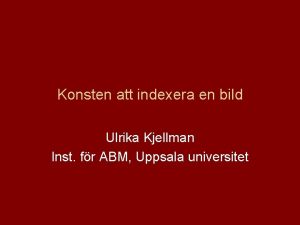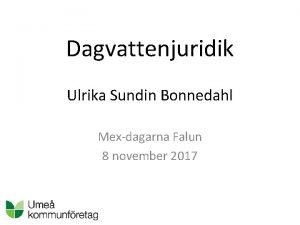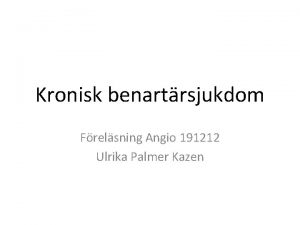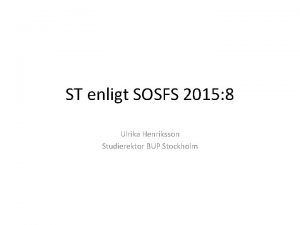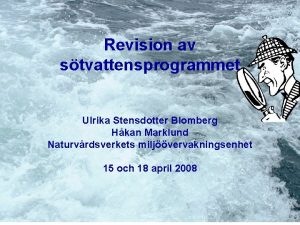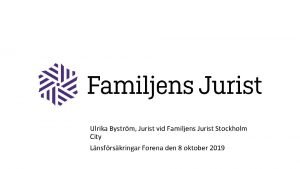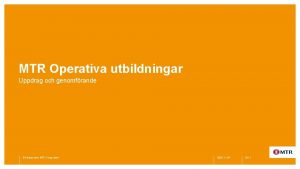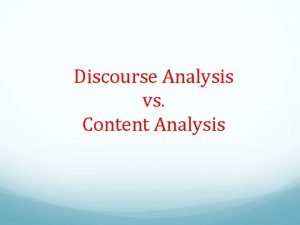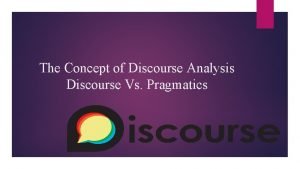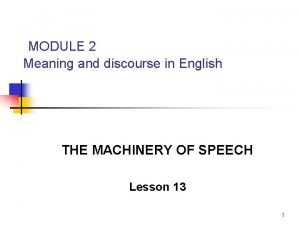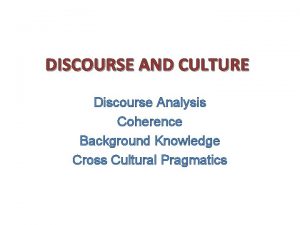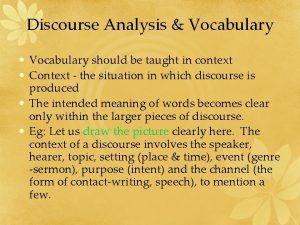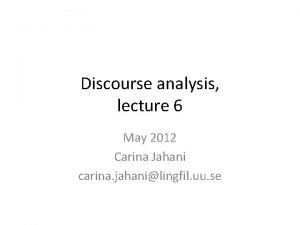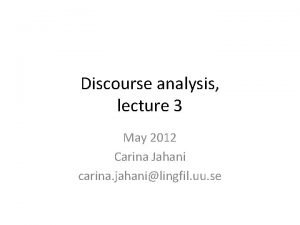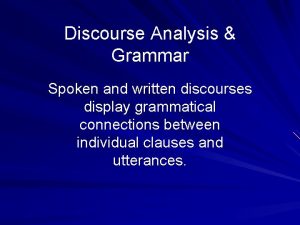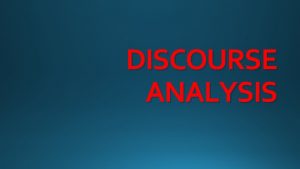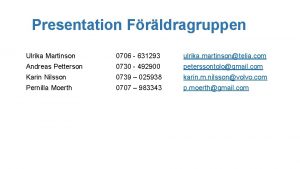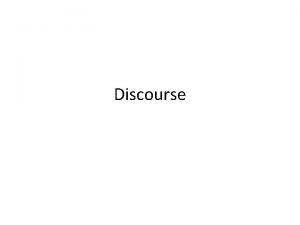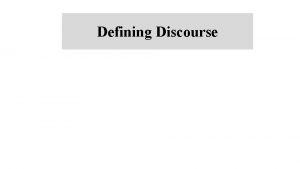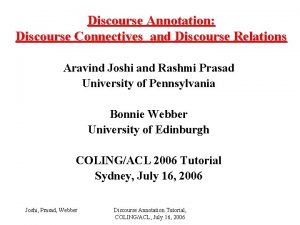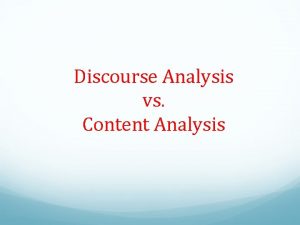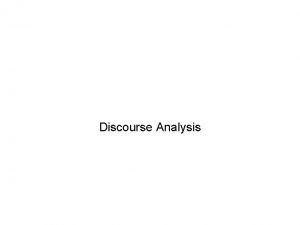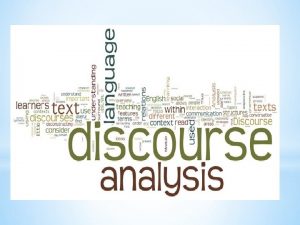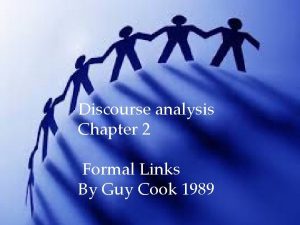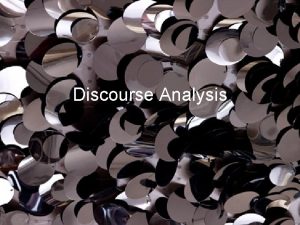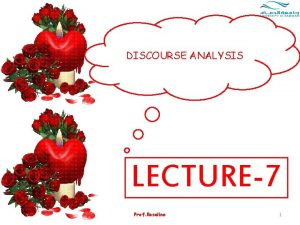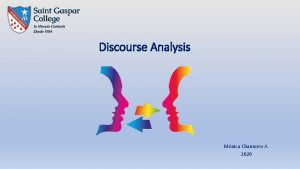Discourse analysis WPR AG 2805HT 20 Ulrika Gunnarssonstling






![Sustainable development “[r]ather than focus on searching for a definitive meaning of ‘sustainable development’. Sustainable development “[r]ather than focus on searching for a definitive meaning of ‘sustainable development’.](https://slidetodoc.com/presentation_image_h2/b0a7c13c21b3398f27fcbcc8cf68372d/image-7.jpg)















- Slides: 22

Discourse analysis - WPR AG 2805/HT 20 Ulrika Gunnarsson-Östling

Today 9: 00 -9: 45 10: 00 -15: 00 -16: 00 Introduction to the method Exercise in smaller groups Seminar

Discourse analysis • Study written or spoken language in relation to its social context • Aim to understand how language is used in real life situations • Examining how meaning is created in different social contexts • Materials consists of e. g. books, newspapers, marketing material, business and government documents, websites, forums, social media posts and comments, interviews and conversations

Discourse “Shared, structured ways of talking, thinking, interpreting, and representing phenomenon, such as sustainable development. ” (Dryzec 1997/2005)

Social constructivism Two starting points: 1. Reality cannot be perceived objectively 2. Reality cannot be perceived subjectively, if so they would be without meaning. 1+2 = (Our perception of) reality is socially constructed

Sustainable development Four approaches to the concept: 1. As unproblematic in principle, even though hard to achieve in practice 2. As ambiguos, thus in need of definition (through choosing one interpretation, and backing this up) 3. As ambiguos, and thus in need of a multi-dimensional representation through e. g. axes or circles 4. As essentially contested, and thus it is how it is put to practice that matters (adopted from Connelly, 2007)
![Sustainable development rather than focus on searching for a definitive meaning of sustainable development Sustainable development “[r]ather than focus on searching for a definitive meaning of ‘sustainable development’.](https://slidetodoc.com/presentation_image_h2/b0a7c13c21b3398f27fcbcc8cf68372d/image-7.jpg)
Sustainable development “[r]ather than focus on searching for a definitive meaning of ‘sustainable development’. . . it is necessary to recognise the multiplicity of sustainabilities and to analyse the ways in which these are shaped and mobilised in political discourse” (Haughton & Counsell 2004, cit. Connelly 2007).

What is the problem represented to be? A specific approach to discourse analysis (Bacchi 2009)

What is the problem represented to be? • Policy has a cultural dimension – takes shape within a certain context. • A policy/plan implies something needs to change – there are implied problems. But what are the problems represented to be? • Bacchi suggests asking six questions to make the problem explicit instead of implicit. • The idea is to help us think deeply about assumptions and presuppositions that lie behind and shape certain policies. • Thus, the idea is not to say that things aren’t good enough, but to show what type of assumptions the policies are based on.

The WPR-approach in short 1. What’s the ‘problem’ represented to be? 2. What presuppositions or assumptions underlie this representation? 3. How has this representation of the ‘problem’ come about? 4. What’s left unproblematic in this ‘problem’ representation? Where are the silences? Can the ‘problem’ be though of differently? 5. What effects are produced by this representation of the ‘problem’? 6. How/where has this representation of the ‘problem’ been produced, disseminated and defended? How could it be questioned, disrupted and replaced?

Solutions are representations Solutions are responses to problems, and thus represents the way problems are represented to be.

The WPR-approach in short 1. What’s the ‘problem’ represented to be? 2. What presuppositions or assumptions underlie this representation? 3. How has this representation of the ‘problem’ come about? 4. What’s left unproblematic in this ‘problem’ representation? Where are the silences? Can the ‘problem’ be though of differently? 5. What effects are produced by this representation of the ‘problem’? 6. How/where has this representation of the ‘problem’ been produced, disseminated and defended? How could it be questioned, disrupted and replaced?

The WPR-approach in short 1. What’s the ‘problem’ represented to be? 2. What presuppositions or assumptions underlie this representation? 3. How has this representation of the ‘problem’ come about? 4. What’s left unproblematic in this ‘problem’ representation? Where are the silences? Can the ‘problem’ be though of differently? 5. What effects are produced by this representation of the ‘problem’? 6. How/where has this representation of the ‘problem’ been produced, disseminated and defended? How could it be questioned, disrupted and replaced?

The WPR-approach in short 1. What’s the ‘problem’ represented to be? 2. What presuppositions or assumptions underlie this representation? 3. How has this representation of the ‘problem’ come about? 4. What’s left unproblematic in this ‘problem’ representation? Where are the silences? Can the ‘problem’ be though of differently? 5. What effects are produced by this representation of the ‘problem’? 6. How/where has this representation of the ‘problem’ been produced, disseminated and defended? How could it be questioned, disrupted and replaced?

The WPR-approach in short 1. What’s the ‘problem’ represented to be? 2. What presuppositions or assumptions underlie this representation? 3. How has this representation of the ‘problem’ come about? 4. What’s left unproblematic in this ‘problem’ representation? Where are the silences? Can the ‘problem’ be though of differently? 5. What effects are produced by this representation of the ‘problem’? 6. How/where has this representation of the ‘problem’ been produced, disseminated and defended? How could it be questioned, disrupted and replaced?

Problem representations have effects • Discursive effects • What can be said and thought • Subjectification effects • How subjects are constituted within problem representations • Lived effects • Material impact of problem representations on bodies and lives

Material effects Who can afford to live sustainably?

The WPR-approach in short 1. What’s the ‘problem’ represented to be? 2. What presuppositions or assumptions underlie this representation? 3. How has this representation of the ‘problem’ come about? 4. What’s left unproblematic in this ‘problem’ representation? Where are the silences? Can the ‘problem’ be though of differently? 5. What effects are produced by this representation of the ‘problem’? 6. How/where has this representation of the ‘problem’ been produced, disseminated and defended? How could it be questioned, disrupted and replaced?

Questioning, disrupting, replacing ”End extreme wealth” by Liv Strömqvist for the Knife album ”Shaking the Habitual”

The exercise In groups of four, make a WPR-analysis of chapter 1 -3 of the Stockholm City Plan. Write down your answers (bullet-points are perfectly fine). Ulrika and Greger will be there to guide you (Ulrika via Zoom and Greger in the class room) The last 30 minutes together with your group, you will receive some questions to reflect upon what you have learnt today. Participate in the seminar

Questions?

Questions to the breakout rooms What are your main learnings from today? Submit your answers at www. menti. com – use the code 45 55 67 6 Are there any things that are still unclear that you would like to receive answers to? Submit your answers at www. menti. com – use the code 45 55 67 6
 What is discourse and discourse analysis
What is discourse and discourse analysis Ulrika kjellman
Ulrika kjellman Ulrika sundin
Ulrika sundin Sfa ocklusion
Sfa ocklusion Ulrika lyckman alnered
Ulrika lyckman alnered Ulrika henriksson
Ulrika henriksson Ulrika stensdotter blomberg
Ulrika stensdotter blomberg Familjens jurist stockholm
Familjens jurist stockholm Mtr utbildning
Mtr utbildning Christoffer gillberg
Christoffer gillberg Discourse analysis and content analysis
Discourse analysis and content analysis The role of context in interpretation slideshare
The role of context in interpretation slideshare Concept of discourse
Concept of discourse Module 2 meaning
Module 2 meaning Informativity
Informativity Discours analysis
Discours analysis Background knowledge in discourse analysis
Background knowledge in discourse analysis Register and signaling vocabulary
Register and signaling vocabulary Madam rabia
Madam rabia Discourse analysis and phonology
Discourse analysis and phonology Deixis in discourse analysis
Deixis in discourse analysis Foregrounding and backgrounding in discourse analysis
Foregrounding and backgrounding in discourse analysis Spoken and written discourse
Spoken and written discourse

